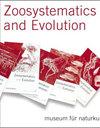补充重新描述深海腹足类 Fimbrora calsubia(Ascidiacea,Enterogona),并推断其系统发育位置
IF 1.6
2区 生物学
Q2 ZOOLOGY
引用次数: 0
摘要
Fimbrora Monniot & Monniot, 1991 是 Ascidiidae Adams & Adams, 1858 科中的一个大食性腹足类属,目前为单型,以 F. calsubia Monniot & Monniot, 1991 为代表。Fimbrora 的分类地位一直很模糊,因为以前的研究对其分支乳头和神经腺开口的特征知之甚少,而这些特征对于区分其他海鞘属是至关重要的。迄今为止,还没有代表 F. calsubia 的核苷酸序列。在这项研究中,我们在距日本本州太平洋海岸约 400 千米、水深 2027 米处采集到一个 F. calsubia 标本。这是该物种的最深记录,也是北太平洋的首次报告。我们的研究表明,Fimbrora 在形态上与另一个 ascidid 属 Psammascidia Monniot(1962 年)相似,咽部只有次生支乳突。我们根据 18S 核糖体 RNA 和细胞色素 c 氧化酶亚单位 I 基因以及公共数据库中 27 个腹足类物种的基因进行了系统进化分析,结果表明 F. calsubia 与 Psammascidia 和 Psammascidia 的亲缘关系更近。与 Ascidia ceratodes(Huntsman,1912 年)、Ascidiella aspersa(Müller,1776 年)和 Ascidiella scabra(Müller,1776 年)相比,Falsubia 与 Ascidia zara Oka,1935 年、Phallusia fumigata(Grube,1864 年)和 Phallusia mammilata(Cuvier,1815 年)的亲缘关系更近。我们的研究结果还表明,在整个海鞘目动物的进化史中,深海成员至少有三次独立地获得了巨型食性。本文章由计算机程序翻译,如有差异,请以英文原文为准。
Supplemental re-description of a deep-sea ascidian, Fimbrora calsubia (Ascidiacea, Enterogona), with an inference of its phylogenetic position
Fimbrora Monniot & Monniot, 1991, a macrophagous ascidian genus within the family Ascidiidae Adams & Adams, 1858, is currently monotypic, represented by F. calsubia Monniot & Monniot, 1991, a species previously recorded from the bottom of the South Pacific at depths of 1000–1860 m. The taxonomic status of Fimbrora has remained ambiguous because characteristics in its branchial papillae and neural-gland opening are incompletely known in previous studies, while these traits are essential for distinguishing other ascidiid genera. So far, no nucleotide sequence representing F. calsubia is available. In this study, we collected a single specimen of F. calsubia at a depth of 2027 m, about 400 km off the Pacific coast of Honshu, Japan. This is the deepest record, as well as the first report from the North Pacific, for the species. Our examination indicates that Fimbrora is morphologically similar to another ascidiid genus, Psammascidia Monniot, 1962, by having only secondary branchial papillae in the pharynx. Our phylogenetic analysis, based on the 18S ribosomal RNA and cytochrome c oxidase subunit I genes, along with those of 27 ascidian species available in public databases, showed that F. calsubia was more closely related to Ascidia zara Oka, 1935, Phallusia fumigata (Grube, 1864) and Phallusia mammilata (Cuvier, 1815) than to Ascidia ceratodes (Huntsman, 1912), Ascidiella aspersa (Müller, 1776) and Ascidiella scabra (Müller, 1776). Our results also indicated that acquisitions of macrophagous feeding by deep-sea members happened independently at least three times in the evolutionary history of the entire Ascidiacea.
求助全文
通过发布文献求助,成功后即可免费获取论文全文。
去求助
来源期刊

Zoosystematics and Evolution
ZOOLOGY-
CiteScore
3.50
自引率
5.00%
发文量
34
审稿时长
16 weeks
期刊介绍:
Zoosystematics and Evolution, formerly Mitteilungen aus dem Museum für Naturkunde in Berlin, is an international, open access, peer-reviewed life science journal devoted to whole-organism biology. It publishes original research and review articles in the field of Metazoan taxonomy, biosystematics, evolution, morphology, development and biogeography at all taxonomic levels. The journal''s scope encompasses primary information from collection-related research, taxonomic descriptions and discoveries, revisions, annotated type catalogues, aspects of the history of science, and contributions on new methods and principles of systematics. Articles whose main topic is ecology, functional anatomy, physiology, or ethology are only acceptable when of systematic or evolutionary relevance and perspective.
 求助内容:
求助内容: 应助结果提醒方式:
应助结果提醒方式:


